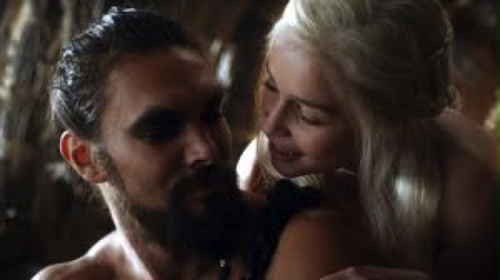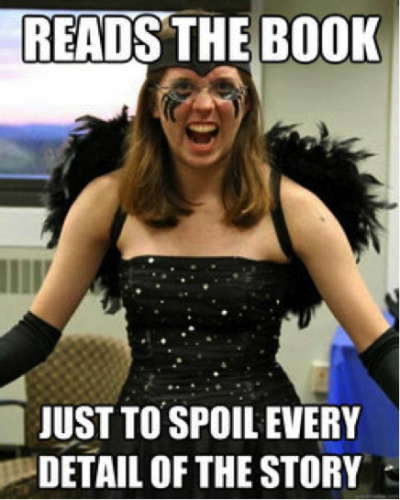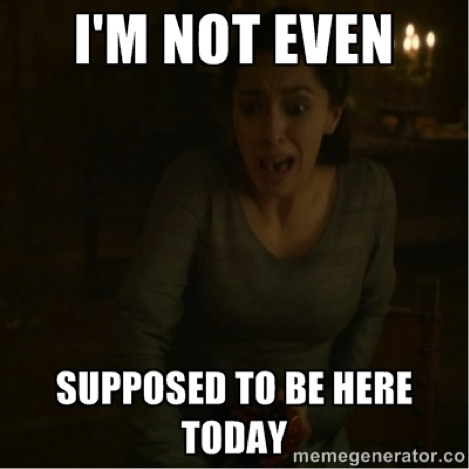This post discusses the HBO show Game of Thrones and George R.R. Martin’s novel series A Song of Ice and Fire. There will be spoilers up until the events of season three’s finale, as well as a discussion of physical, emotional, and sexual violence against women.
 I admit it—I am one of those insufferable people who read the books. I’m the worst kind of Game of Thrones viewer—the one who can’t watch an episode without pointing out how “in the books, x happens this way instead.” I love telling fellow GoT viewers that Tyrion Lannister actually led the vanguard in the battle between Stark and Lannister, rather than being knocked unconscious before the fighting began. I get a sick pleasure from describing how Daenerys’ hair is completely burned away when she survives Drogo’s pyre funeral. And yes, it still chaps my ass that the show denies Samwell Tarly the triumph of sending out the ravens after the battle with the White Walkers at the Fist of the First Men.
I admit it—I am one of those insufferable people who read the books. I’m the worst kind of Game of Thrones viewer—the one who can’t watch an episode without pointing out how “in the books, x happens this way instead.” I love telling fellow GoT viewers that Tyrion Lannister actually led the vanguard in the battle between Stark and Lannister, rather than being knocked unconscious before the fighting began. I get a sick pleasure from describing how Daenerys’ hair is completely burned away when she survives Drogo’s pyre funeral. And yes, it still chaps my ass that the show denies Samwell Tarly the triumph of sending out the ravens after the battle with the White Walkers at the Fist of the First Men.

What I’m talking about here is the unavoidable shift that occurs when content is remediated—that is, borrowed from one medium and reimagined in another. In this case, the content of the book series A Song of Ice and Fire (ASOIAF) is remediated to Game of Thrones, the HBO television series. Some of the differences in this instance of remediation seem pragmatic—remembrances are turned into scenes of their own, dialogue is shortened, characters omitted or altered for the sake of brevity and clarity. I am no purist, and I recognize that with remediation comes necessary alteration for the content to suit the new medium. But other differences speak volumes about our cultural biases and expectations surrounding those with socially-othered bodies—like Tyrion, Sam, and, of course, women. What can we say about these differences? And perhaps more importantly, what do they say about us?
Two examples of these changes from book to TV stick out in my mind, both relating to violence against women. The first is the scene in which Khal Drogo and Daenerys Targaryen consummate their marriage (season 1 episode 1). The HBO series depicts a fairly straightforward rape scene in which a brown-skinned “horse lord” forces himself upon his young white bride while she weeps in pain, comforted only by the sight of her dragon eggs. The book, however, tells a very different story. Here is a (fairly graphic) passage from the book:
“She could sense the fierce strength in his hands, but he never hurt her. He held her hand in his own and brushed her fingers, one by one. He ran a hand gently down her leg. He stroked her face, tracing the curve of her ears, running a finger gently around her mouth. He put both hands in her hair and combed it with his fingers. He turned her around, massaged her shoulders, slid a knuckle down the path of her spine […] He cupped her face in his huge hands and she looked into his eyes. ‘No?’ he said, and she knew it was a question. She took his hand and moved it down to the wetness between her thighs. ‘Yes,’ she whispered as she put his finger inside her.” (A Game of Thrones, 108)
Let’s get one thing straight—in Martin’s series Daenerys Targaryen is a thirteen-year-old child who has been sold into marriage by her brother for political reasons. The scene above is not consensual sex. She is coerced and, at least by our standards, too young to consent to sex. I have no intention of making some over-simplified case for “book GOOD, TV show BAD.” Recognizing this, the fact remains that this passage depicts Drogo as downright tender—and throughout the book series the Dothraki, and Drogo in particular, are much more complex and robust characters than their TV counterparts. Is it so far beyond the realm of imagining that Drogo would be gentle towards his new bride? What does it say about popular culture, and the media content created for it, that a violent sex scene is inherently more interesting than an affectionate one? Why do we prefer to see a brown man forcibly rape a white woman, rather than romance her? This example in particular highlights the racist and sexist assumptions about dark-skinned “savages” and the purity of white women that predominate popular media artifacts.
Another example comes from the dreaded Red Wedding episode [season 3 episode 9] in which the Freys and Boltons plot to murder the Starks during the wedding of Edmure Tully and Roslin Frey. The events depicted in the book and those in the TV series are mostly the same, with one glaring difference—Rob Stark’s pregnant wife Talisa is killed after receiving multiple stab wounds in her stomach. This is one of the differences between the books and TV show that absolutely bowled me over. I couldn’t quite wrap my head around it. For starters, Robb’s wife is a completely different character in ASOIAF and doesn’t even attend the wedding.
Talk about bad luck
Was the cruel betrayal and murder of almost every member of the beloved Stark family not enough gore and violence for the writers? Maybe Robb being filled with arrows, or Catelyn’s sorrowful wail as her throat was slit didn’t have enough shock value to thoroughly horrify viewers. Who can say? But the inclusion of the gratuitous and gruesome murder of Talisa Stark is a prime example of how popular media glorifies acts of violence against women, often for no other purpose than to grab a few more eyeballs.
After all, that’s the purpose of TV, isn’t it? To attract as many viewers as possible and generate advertising revenue. Television producers sell eyeballs. Talisa’s murder does nothing to further the plot and deviates from Martin’s writing in such a way that begs the question: What is it about violence against women that makes for “good” (read: compelling) TV? Why does Drogo need to violently force himself on Daenerys? Why does Talisa need to be stabbed in her pregnant belly? What does it say about our popular culture that these are the changes TV writers choose to make?
I think the funhouse mirror is a useful metaphor for understanding this process. Media representations reflect back at us an exaggerated, sometimes grotesque image of ourselves—the hips too wide, the nose too long, the feet to large. In other words, media representations often reveal and amplify some of our society’s least appealing characteristics. From this perspective, it seems reasonable that a cultural mainstream that publicly shames victims of rape and financially punishes survivors of domestic violence also produces media artifacts that go out of their way to depict graphic acts of violence against women.
Of course, media products don’t just reflect us. We absorb them; we use them to inform ourselves about ourselves, in a creative and recursive process of making and remaking. In their work on remediation, new media theorists Jay David Bolter and Richard Grusin argue [PDF] that “our culture still needs to acknowledge that all media reproduce the real,” and that remediation is a “process of reforming reality” as well as media content (346). These acts of remediation aren’t just funhouse mirrors, revealing our less flattering features for the sake of a laugh—they are cultural practices that make and are made by us. Those of us thinking hard about technology and media should pay close attention to how these remediations “reform reality.”
When asked in an interview how he writes such diverse and dynamic female characters, George R.R. Martin replied by saying “I’ve always considered women to be people.” Even in the HBO series, the characters are mostly complex and richly developed. Game of Thrones is certainly doing a better job than many others at portraying women as powerful, self-determined individuals (I’m looking at you, Big Bang Theory), but that doesn’t mean we don’t have a long way to go. We should hope for and work towards media content that can deliver characters like Brienne of Tarth, Arya Stark, and Ygritte without relying on lazy and unsatisfying tropes like “brown man rapes white woman.” If remediation truly has the power to reform reality, it should at least attempt to do so for the better.
Britney Summit-Gil is a PhD student of Communication and Media at Rensselaer Polytechnic Institute. You can follow her on Twitter @beersandbooks for strange drink recipes and pictures of her cats.


Comments 6
Jane — July 12, 2013
I would encourage you to look more at violence in entertainment. Violence on television isn't new. Maybe violence regarding women seems to be more... glorified(?), but violence in entertainment isn't new. In fact, during medieval times, bloodshed was demanded by the audience.
Friday Roundup: July 12, 2013 » The Editors' Desk — July 12, 2013
[...] Taking on the airwaves: Women are getting the worst on Game of Thrones and Dr. Who, while Black Mirror freaks everyone [...]
Matt — July 18, 2013
I'd like to point out that while it is true that GoT depicts violence against women, it also depicts violence against men, much more violence. I do not have numbers here, but from my GoT viewing experience the bloodshed of men in the series far exceeds the bloodshed of women. So, while I agree that violence against women is depicted often within the series, and other media alike, violence against men is even more common. I in no way mean to undercut the fact that depictions of violence can be dangerous for women, but depictions of violence are not dangerous for women exclusively. Male disposability and its lack of recognition is also an issue here.
Zimmerman media coverage, remediation in Game of Thrones, Scorcese on reading cinema, and much more | COOL MEDIUM — July 30, 2013
[...] Cyborgology contributor Britney Summit-Gil writes about remediation and violence against women in the Game of Thrones tv series: [...]
DAKrolak — August 21, 2013
Yes, to leave out the cutting off of Theon's penis seems a great big oversight. Granted the violence against women is far more prevalent both in our society and glorified (almost as feigned sexual gratification) in our media. Your analysis of this is very insightful and I agree with it totally - and as a reader of the books it struck me as well that many of the changes they made were more a reflection on them giving the audience what they THINK they want instead of being more original. They also left out BELWAS, who plays an integral part to me in the books, but was cast aside - he would have been the largest (body wise) character out there as well.
Since HBO doesn't rely on advertisers they are in less of a struggle for eyeballs as well, plus they've said having the #1 pirated show on the web is actually a good thing, so they are still concerned with viewership and audience size but to a lesser degree than Hollywood and others.
Thanks for writing this, it always amazes me the depth of appreciation and critiques that GoT/ASOIAF receives - each time it always floors me that people connect so concretely with the characters Martin created.
Jason Litzau — August 25, 2013
I've been saying this for a while after the last season ended. The Game of Thrones TV series is far worse to women, than the books. To the point where is comes off like cheap shock tactics. Lets go over some of the things altered from the books, just for the sake of shocking us with dead women.
1. Ros
Wasn't even in the book, at all. Hired to pretty much act as eye candy, and then killed horribly by Joffrey.
2. Jeyne Westerling/Talisa Stark
Wasn't even at the Red Wedding. Murdered by stabbing. In the uterus of all places, with a unborn child.
3. Aegon Fray (Aka Jinglebell)
Was literally replaced with one of Walder Fray's underaged wives, then killed by Catelyn Stark at the Red Wedding, just before Catelyn is murdered as well.
So the GoT producers invented a woman to kill. Took another that lives, and transplanted her to a scene just to kill her. Then replaced a man with a girl, just to kill another female, just before the woman that kills her is also killed.